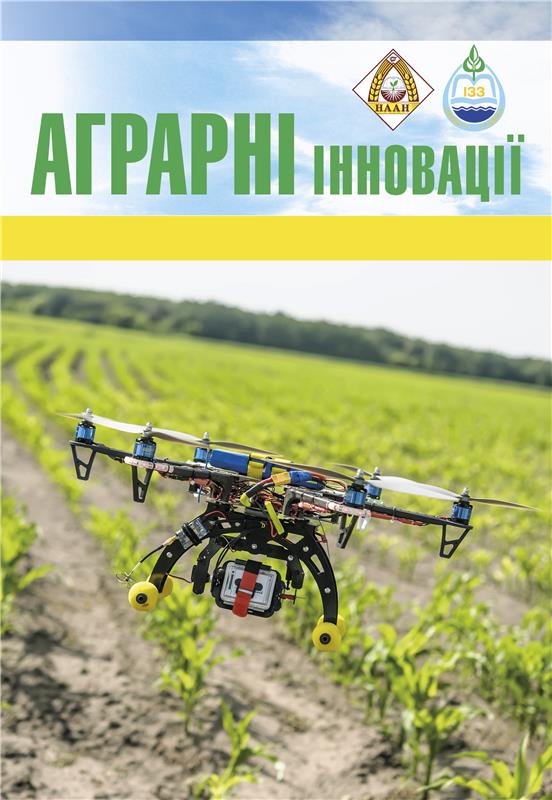THE INFLUENCE OF WEATHER CONDITIONS IN THE SPRING-SUMMER PERIOD AND VARIETAL CHARACTERISTICS ON THE FORMATION OF GRAIN QUALITY OF SOFT WINTER WHEAT
Abstract
One of the main genetic characteristics of a winter wheat variety is its baking qualities of grain, which affect the food class. However, wheat grain is often formed of low quality, which affects its price and profitability of production.Air and soil droughts during the period of grain filling often affect the formation of its quality, in particular, the mass fraction of protein and gluten. It is the correct selection of the variety that will contribute to the necessary agrotechnical measure in the Southern Steppe of Ukraine, which will contribute to the increase in the production of high-qualitygrain. The purpose of the research is to establish the influence of varietal characteristics and weather conditions in the interphase period "Earing – milky-wax grain maturity" on the formation of the mass fraction of protein and gluten. Experimental research was carried out during 2017-2023 on southern chernozem under the conditions of the Educational-Scientific-Practical Center of the Mykolaiv National Agrarian University with twenty varieties of winter wheat. Field, laboratory and comparative calculation methods were used during the research. The establishment and conduct of experiments were carried out according to the methodology of the research case. Grain quality was determined by infrared spectroscopy. It was determined that the higher protein content in the grain of the investigated winter wheat varieties was formed in 2023 – 15.2%, while the lowest – 12.3% in 2021. The greater mass fraction of gluten in the grain was formed in 2023 – 31.8%, slightly smaller (29.5%) in 2019 and the smallest (25.3%) in 2021.Analyzing the influence of weather conditions in dry, moderate and wet years, it was determined that a larger mass share of protein (14.4%) and gluten (29.2%) in grain, on average by variety, was formed by wheat plants in years with moderate moisture content (2020, 2023) with the sum of effective temperatures of 410.7 °С and the sum of precipitation for the reporting period of 71.6 mm. The obtained scientific research results will contribute to the wider introduction of strong and valuable varieties, which will contribute to the increase in the production of high-quality food grains.
References
2. Рибалка О. І., Поліщук С. С., Червоніс М. В., Моргун В. В., Моргун Б. В. Унікальна пшениця спельта (Triticum aestivum SSP. Spelta L.) з темно – фіолетовим зерном. Фізіологія рослин і генетика. 2024. Т. 56. № 5. С. 419-430. https://doi.org/10.15407/frg2024.05.419.
3. Рибалка О. І., Моргун В. В., Моргун Б. В., Поліщук С. С., Червоніс М. В., Соколов В. М. Нова генетична варіабельність для поліпшення якості пшениці (Triticum aestivum L.). Цитологія і генетика. 2023. Т. 57. № 1. С. 3-16. https://doi.org/ 10.3103/ s0095452723010103.
4. Korkhova M., Panfilova A., Domaratskiy Y., Smirnova I. Productivity of winter wheat (T. aestivum, T. durum, T. spelta) depending on varietal characteristics in the context of climate change. Ecological Engineering & Environmental Technology. 2023. 24. P. 236-244. https://doi.org/10.12912/27197050/163124.
5. Korkhova M., Mykolaichuk V. Influence of weather conditions on the duration of interphysical periods and yield of durum winter wheat. Scientific horizons. 2022. 25(2). P. 36-46. https://doi.org/10.48077/ scihor.25(2).2022.36-46.
6. Кривенко А. І. Економічна ефективність елементів технології вирощування пшениці озимої у сівозмінах Південного Степу України. Наукові доповіді НУБіП України. 2019. № 2 (78). http://dx.doi.org/10.31548/ dopovidi2019.02.015.
7. Мірзоєва Т. В., Гуртовенко В. О. Економічна ефективність виробництва пшениці озимої в розрізі виробничих витрат. Бізнес Інформ. 2018. № 10. С. 203-208. https://www.business-inform.net/export_pdf/business-inform-2018-10_0-pages-203_208.pdf.
8. Гречишкіна Т. А. Економічна ефективність вирощування сортів пшениці озимої залежно від системи удобрення та методів захисту рослин в умовах Південного Степу України. Таврійський науковий вісник. 2021. № 122. С. 10-17. https://doi. org/10.32851/2226-0099.2021.122.2.
9. Ярчук І. І., Мельник Т. В., Маслійов С. В. Особливості вирощування та економічні показники пшениці твердої озимої в Степу. Таврійський науковий вісник. 2019. № 108. С. 123-129. https://doi. org/10.32851/2226-0099.2019.108.17.
10. Грабовський П. В., Коковіхін С. В., Писаренко П. В., Найдьонов В. Г. Економічна ефективність елементів технології вирощування пшениці озимої при зрошенні в умовах Південного Степу України. Зрошуване землеробство. 2011. Вип. 56. С. 284-288.
11. Астахова Я. В., Гасанова І. І., Кулик А. О. Ефективність вирощування пшениці озимої залежно від строків сівби та удобрення в Північному Степу. Вісник Полтавської державної аграрної академії. 2021. № 4. С. 91-97. DOI: https://doi.org/10.31210/ visnyk2021.04.11.
12. Маренич М. М., Дяжук Р. У. Економічна ефективність вирощування органічної пшениці в умовах недостатнього зволоження Степу України. Вісник Полтавської державної аграрної академії. 2022. № 2. С. 92-99. DOI: doi:10.31210/visnyk2022.02.10.
13. Закупівельні ціни Нібулон. URL: https://www.nibulon. com/zakupivelni-tsiny-na-zernovi-kultury/ (дата звернення: 23.12.2024)
14. Agrotender. URL: https://agrotender.com.ua/traders/ region_ukraine/pshenica_tverdaia_iarovaia. (дата звернення: 23.12.2024)
15. Державний реєстр сортів рослин придатних до поширення в Україні станом на 01. 07. 2024 р. https:// minagro.gov.ua/file-storage/reyestr-sortiv-roslin.
16. Надвиничний, С. А. Методологія дослідження економічної ефективності виробництва сільськогосподарської продукції. Економічний аналіз. 2016. Т. 25. № 2. С. 115-121.






